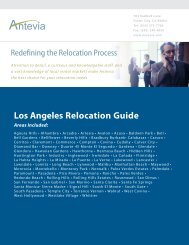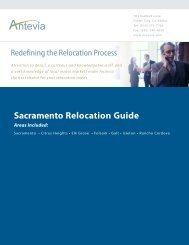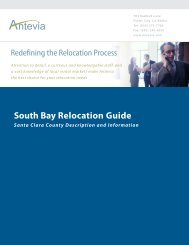San Francisco Relocation Guide - Antevia
San Francisco Relocation Guide - Antevia
San Francisco Relocation Guide - Antevia
Create successful ePaper yourself
Turn your PDF publications into a flip-book with our unique Google optimized e-Paper software.
History<br />
The Castro came of age as a gay center following the controversial Summer of Love in<br />
the neighboring Haight Ashbury district in 1967. The gathering brought tens of thousands<br />
of middle-class youth from all over the United States. Dreams of love, peace, drugs, and<br />
sex were dashed as conditions quickly deteriorated and violent crime became rampant.<br />
During the 1950s and 1960s, when families left the big cities for the suburbs, the Eureka<br />
Valley also suffered this fate. By the early 1970s, rents were low and people who had<br />
been pushed out of homes by the gentrification of the district nearby began to settle in the<br />
Eureka Valley. Local real estate agents played a key role in the process of gentrification.<br />
By 1975, Harvey Milk had opened a camera store there, and began active political<br />
involvement as a gay activist, further contributing to the notion of the Castro as a gay<br />
destination. Some of the culture of the late 1970s included what was termed the "Castro<br />
Street Clone", which was a mode of dress in vogue with the gay population at the time,<br />
and which gave rise to the nickname "Clone Canyon" for the stretch of Castro Street<br />
between 18th Street and Market Street. There were numerous famous waterholes in the<br />
area, contributing to the nightlife, including the Corner Grocery Bar, the Norse Cove, the<br />
Pendulum, and the Elephant Walk. A typical street scene of the period is perhaps best<br />
illustrated by mentioning the male belly dancers who could be found holding forth in<br />
good weather at the corner of 18th and Castro, on "Hibernia Beach", in front of the<br />
financial institution from which it drew its name.<br />
The area was hit hard by the AIDS/HIV crisis of the 1980s. Beginning in the 1980s, city<br />
officials began a crackdown on bath houses and launched initiatives that aimed to prevent<br />
the spread of AIDS. Kiosks lining Market Street and Castro Street now have posters<br />
promoting safe sex and testing right alongside those advertising online dating services.<br />
Like any other part of a vibrant city, the gay community and Castro neighborhood<br />
continue to address these and other issues of gender, race and class amongst others.<br />
Notable locations<br />
Castro Theatre<br />
Corner of 18th St.-Castro<br />
ESPN Broadcasting Relay Centre (SportsCenter is taped here)<br />
The F Market heritage streetcar line's turnaround at Market St.-17th St.-Castro<br />
The Castro Street Station, a Muni Metro subway station







